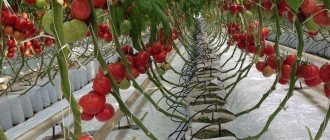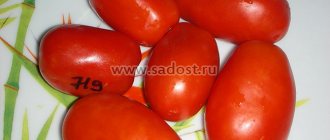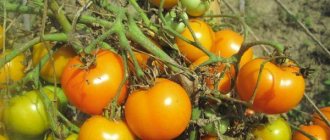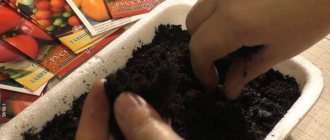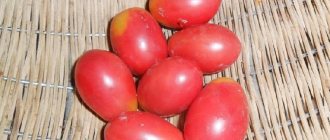Description of the variety
Tomato Octopus Cream - medium-term high-yielding hybrid:
- A powerful indeterminate bush is often called a “tomato tree.” The plant grows up to 2.5 m, has a developed root system and abundant green mass.
- The leaves are small, dark green, the fruits are collected in large, heavy clusters of 8-12 pieces.
- Ripening is dense, friendly. The plant is very productive; from 1 m2 of planting up to 10 kg of selected tomatoes can be harvested. The clusters on the lower branches are no different from the upper ones, the fruits are equal in weight and size.
- The fruiting period is long, harvesting begins in the second half of June, the last ovaries form in the fall.
- The fruits are medium-sized, weighing 30-40 g, smooth and neat. The shape is oval, slightly elongated. The color of ripe tomatoes is bright red; the thick, shiny rind gives them an elegant appearance and protects them from cracking. The pulp is juicy, multi-chambered, moderately dense. The taste is pleasant, refreshing, sweet with a slight sourness.
Description
It belongs to the mid-late varieties, ripe fruits appear already on 110-115 days. The bushes are indeterminate, are not limited in growth, and can reach a height of up to two meters. This variety can be grown throughout Russia, but in regions where climatic conditions are unpredictable, planting in greenhouses is recommended.
The stem is thick and powerful, the leaves are potato-type. The fruits are large, have a flat-round shape, are arranged in clusters of 3-5 pieces, and when ripe they are colored crimson-pink. Their weight can be from 250 grams or more. The pulp is dense, sweetish in taste. Tomatoes are suitable for preparing salads, juices, various sauces and lecho. They are not canned whole, as they simply won’t fit into the neck of the jar.
Characteristics of the variety
Features include:
- Hybrid species that increase resistance to various adverse weather conditions, disease attacks, and pests.
- Refers to varieties with medium-term ripening.
- The bushes are powerful and spreading. Support required. Has a developed root system.
- The fruits are formed on clusters of 8-12 pieces. One square meter can produce more than 10 kg of tomatoes; in general, a tomato tree can occupy up to 50 square meters of area.
- The harvest begins from the second ten days of June until the end of autumn.
- The trunk of the tomato tree gradually begins to become woody.
- It requires a very strong frame in the greenhouse and enough space, light and heat.
- In general, they are unpretentious and do not require special conditions in terms of nutritious soil or its acidity. It grows well on simple humus and responds well to all feedings.
- The leaves on the tomato tree are dark green, but not large.
- Belongs to an indeterminate species, no finite growth.
- Tomatoes of the Sprut Slivka variety weigh 30-40 grams. The fruits ripen in 100-110 days.
- The variety is grown by seedlings and hydroponics.
- The fruits do not crack. Thanks to this quality and long-term storage, it can be transported over long distances, which justifies growth for sale. The fruits have a very pleasant tomato aroma and taste, juicy pulp, and slight acidity.
- Suitable for cultivation in all regions of our country. Can be grown both in a greenhouse and outdoors.
- It has a universal table purpose - suitable for canning, eating fresh, for sauces, juices, pasta.
- They are highly resistant to disease. But it is better to carry out preventative maintenance.
- The bushes do not need to be pinched, otherwise this variety will lose its harvest.
Advantages and disadvantages of the variety
The main advantage of the Sprut Slivka variety is its high yield.
The elastic peel of the fruit allows them to be stored for a long time, transported and closed for the winter in their entirety.
pros
- outstanding flavor and versatility of tomatoes;
- long fruiting;
- high resistance to pests and diseases;
- ease of cultivation and care.
Minuses
- demanding soil nutritional indicators;
- bushes need to be formed;
- needs frequent feeding.
The positives outweigh all the negatives. Therefore, this variety is very popular among novice gardeners and professionals.
Features of cultivation
Growing the Sprut Slivka variety can be done in this way:
- in open ground, in a shelter without heating, but for 1 season. Productivity can be up to 12 kg from one plant;
- in a heated room in cold weather - in a greenhouse, on a balcony, loggia for a long time.
Special agricultural technologies are used. As a result, the tree grows abundantly: up to 1.5 tons of tomatoes per year.
In the garden and in the greenhouse, it is better and easier to grow a variety of tomatoes intended for one growing season. Cultivation over a long period of time requires cultivation techniques and technology that is more accessible on an industrial scale.
Planting seeds
In the middle zone, Sprut Slivka tomato seeds are planted in special containers in January-February in enclosed spaces (balcony or loggia). In the southern regions you can also sow in open areas. During germination, it is important to provide lighting and heating. Since seeds germinate at 20-25 degrees, the last stage of growing seedlings is planting.
Transplanting
Tomato seedlings are carried out in early summer to a permanent place of growth. On young plants, the length of 15-30 cm should be 5-7 leaves. The distance between tomatoes should ideally be up to 1.5 meters, because it is a large tree or shrub.
Soil and location requirements
Soil and fertilizers play an important role. Growing Sprut Cream tomatoes is best produced on soil with a predominance of sand and clay impurities. The presence of humic acids is welcome.
Fertilization of any land can be independently prepared with compost or special soil for tomatoes.
Octopus Slivka tomatoes love the sun and do not tolerate windy areas.
The ideal temperature is at least 25 degrees. Otherwise, fruit ripening will be prolonged.
Step by step planting instructions:
- Filling holes with a depth of 20-22 cm.
- Clamping the main root for better branching.
- Planting seedlings so that the lower leaves are higher than the ground.
- In addition, Sprut Slivka tomato seedlings need proper care.
Growing seedlings
The quality and productivity of tomatoes directly depends on the care of even the seeds. First, they are checked for germination to find out which seeds are unsuitable for planting, then they are disinfected in a manganese solution and finally soaked in a growth stimulator.
The soil is also prepared, first sifted through a sieve to get rid of debris and larvae. For disinfection, you can use calcination in the oven or pouring boiling water with the addition of the same manganese. The seeds are sown at a distance of 2 cm from each other, sprinkled with soil mixed with sand on top. After watering, to create a greenhouse effect, you can cover the containers with future seedlings with film. After the shoots emerge, you need to remove it and water the hatched sprouts.
Compliance with the following conditions will help to grow strong and powerful seedlings:
- Plants should have at least 16 hours of daylight.
- Comfortable temperature for seedlings during the day is +20-23, at night + 18-20 degrees.
- Ensuring the room is ventilated, but without drafts.
- Regular watering.
- Feeding with nutrients.
- Timely picking and transplanting into the soil.
- Hardening of seedlings before transferring to a permanent place.
Care
Growing Sprut Slivka tomatoes comes down to implementing the following rules:
- Fertilize with minerals and organic fertilizers three weeks a week;
- To ensure that the height of the plant does not reach 4-5 meters per season, it is necessary to pinch - remove the top of the tomato;
- pinching will only destroy the harvest - this should not be done;
- to prevent diseases, the roots are treated with a water-iodine solution - a bottle in a bucket;
- watering regularly and abundantly;
- old and wilted leaves are removed to avoid diseases and to better ventilate the entire plant;
- long brushes are tied, for wood, if necessary, support is provided in the form of sticks or special devices.
From the moment the seedlings are planted in the ground until the first mature fruit appears, no more than 110 days pass. Greenhouse plants bear fruit faster and more abundantly.
Growing in a greenhouse
A tomato tree can grow to gigantic sizes, so the greenhouse must be large.
To grow a healthy crop in greenhouse conditions, the soil must contain nutrient solutions - hydroponics.
Tatyana Orlova (Vasilidchenko) (candidate of agricultural sciences):
Hydroponics is used only in industrial greenhouses; this method is practically not available to ordinary gardeners. A regular ground greenhouse is the simplest and most suitable option.
The plant is planted in autumn. The greenhouse should be equipped with heating and warm-colored lighting. Proper growth requires at least 12 hours of light.
Tomatoes should be wintered at a temperature of at least 20 ℃, and in summer no more than 26 ℃. If the technology is not followed, the tree will grow no more than 2 m. To stop the immense growth, a mesh is made under the ceiling, this forces the crop to spread directly over it.
Tatyana Orlova (Vasilidchenko) (candidate of agricultural sciences):
To become a “tree”, i.e. To grow a tomato to a height of 5-10 m, you need the appropriate dimensions of the greenhouse, and most importantly, the greenhouse must be heated. In a regular greenhouse, the height of plants of this variety will not exceed 2-2.5 m, and the duration of fruiting will not exceed the end of October. With the onset of severe cold, the plant dies.
The mother liquor is used as fertilizer. To prepare it you will need:
- 200 g ammonium nitrate;
- 500 g potassium;
- 0.9 mg lemon iron;
- 550 g of superphosphates;
- 300 g boric acid;
- 300 magnesium;
- 0.2 mg manganese sulfate.
After this, 1 liter of solution is diluted with 100 liters of water and mixed. Growing seedlings begins in August. A month later, a solution is added to them and moistened several times a day. After 2 months from the emergence of seedlings, the seedlings are placed in a large container and air supply tubes are connected to them and covered with a lid.
Diseases and pests
The tomato variety Sprut Slivka is resistant to many typical diseases of salt marshes:
- fusarium;
- verticillium;
- tobacco mosaic.
Verticillium
To prevent late burns, spraying copper-containing preparations is recommended. Frequent loosening, mulching of the soil, thorough watering and frequent ventilation of the greenhouse will prevent gray, top or root rot. Tomatoes are often affected by:
- aphids;
- thrips;
- spider mites.
To prevent bushing, you can sprinkle with a weak solution of potassium permanganate. In severe cases, industrial insecticides are used, treatment is carried out 2-3 times with an interval of several days.
Problems during cultivation
With the onset of autumn, tomatoes are in danger of rotting. This scourge comes with wet weather, damaging the fruit and plant from the inside. It appears as brown spots and progresses very quickly. In open ground conditions it is less common than in a greenhouse.
The crop absorbs water unevenly. The best prevention is timely and moderate watering, after which the soil is loosened. Mulch can prevent the development of rot: in the greenhouse you need to ensure that the temperature does not rise above normal. Excess fertilizer can also be a problem. In the fight against blossom end rot, a solution of calcium nitrate is used.
Pests
When growing Octopus tomatoes, gardeners often encounter the appearance of a caterpillar. It devours not only the leaves, but also the fruits of the tree from the inside. As a fight, you can turn to folk remedies.
- Wormwood decoction. Pour 0.5 kg of wormwood into 1 bucket of water and boil for half an hour. Leave for 2 days, strain and dilute with water 1:10 and add 1/3 of the soap. Spray twice a month.
- Tobacco infusion. Boil 1 bucket of water and add 0.3 kg of fine tobacco. Leave for 24 hours and add soap. Spray until the pest disappears.
Tatyana Orlova (Vasilidchenko) (candidate of agricultural sciences):
If you want to really exterminate pests, use real products - insecticides. Many gardeners are afraid to use them, resorting to “folk remedies” that no longer “work”. The main thing is to use chemical insecticides in the most vulnerable phase of life for these insects, then you won’t have to spray a lot and often. The caterpillars of the cotton bollworm (it is the one that “makes holes” in tomatoes) have the most vulnerable phase—the caterpillars that have just hatched from the eggs. Clutches of these eggs can be found on the surface of the fruit. When a brown dot appears in these white eggs, this means that in 1-1.5 days a caterpillar will emerge from the eggs. It is at this time that the plants need to be treated. Otherwise, the emerging caterpillars gnaw through the fruit and penetrate into it, making further processing pointless.
Aphids may appear; sprinkling the foliage with cold water or a solution of 0.3 cayenne pepper, 1/3 laundry soap and 10 liters of water helps.
Diseases
Those who have already planted this variety say that it has quite strong immunity to various kinds of diseases, but in some cases it can be affected by late blight. Its symptoms are similar to rot, but it is more difficult to get rid of because... it's a fungus. It spreads quickly and affects the fruits and trunk of the tree, gradually reaching the root.
Turn to traditional methods: a decoction of wormwood is considered effective. If the disease progresses, you should resort to the following drugs: Alyette or Quadris. Aliette is sprayed up to 5 times a year, and the crop is harvested no earlier than 5 weeks after treatment. To do this, use a 0.5% solution at a rate of 3 kg/ha.
Photo
The Octopus tomato variety is very famous both among gardeners and active Internet users. The photographs below will help you study this variety in more detail.
Octopus Cream Chocolate F1
You can also watch a video where an experienced gardener will tell you about the pros and cons of the Octopus variety.
Tomatoes Sprut Slivka - Big Beef are an excellent purchase for any gardener. Tall bushes do not take up much space in the greenhouse, providing the family with healthy and tasty fruits throughout the summer season.
Tomato Octopus cream, video
If you grew Sprut cream F1 tomatoes, please write what the yield and height of the bush were under your conditions? Will you grow this hybrid again? If possible, attach a photo of the entire bush as a whole or individual fruits you grew. Thank you!
Your reviews of the Octopus cream tomato and additions to the description will help many gardeners evaluate this hybrid objectively and decide whether it is worth planting or not.
I have already written many times about a super tasty tomato called Sprut Cream from. I’ve been planting this for three years now and I’ve never seen anything tastier. The pulp is very dense, rich red color and very, very! sweet taste. Sprut Slivka is a mid-early hybrid, up to 3 meters high. The value of this tomato is also that it is resistant to verticillium wilt, tobacco mosaic virus, and is quite heat-resistant.
These tomatoes bear fruit until frost. I took the last ones at the end of October. The shape of the fruit, as you can see, is oblong, hence the name - cream. I sow seeds at the beginning of March, and at the end of April I plant them in a greenhouse. The care is the same as for all other tomatoes. Watering, fertilizing.
Tomato care
Be sure to tie up the bushes
Proper care affects yield, fruit quality and disease resistance. The following rules will help you grow Octopus tomatoes:
- The culture does not need pinching, so it cannot be carried out;
- feed with organic and inorganic mineral fertilizers 3 times a week;
- a tree can grow significantly over a season: to prevent this, its top is cut off;
- water the tree regularly and in the right amount;
- dried leaves must be removed to avoid the development of diseases;
- high branches are tied up, you can make a support from a stick.
To protect the roots from the development of diseases, they are treated with an iodine solution. It is prepared from 10 liters of water and 1 bottle of iodine. Water the plant with the solution once. During the first days after planting, seedlings need abundant watering. The soil moisture level should be at least 60%; irrigate only with water at room temperature.
To fertilize the soil, use the following composition: compost and soil in equal quantities fill the container 1/3 full. Fill with water and leave for a day. Feed from July until fruit harvest 2-3 times a week.
It is better to resort to hydroponics - a special technology thanks to which the plant grows not directly in the soil, but in an artificial environment enriched with micronutrients. This significantly increases the yield and sustainability of the tree.
Varieties of tomato tree
Sprut F1 tomatoes include several varieties that differ from each other in some characteristics.
- Rotamer is a salad variety that is used not only in classic recipes. Desserts are often made from it; the fruit has a pronounced sweet aftertaste.
- Inka Gold - apricot tomatoes: both in taste and color they resemble this fruit.
- Octopus Slivka F1 is a mid-early hybrid that brings a rich harvest (you can get up to 10 kg/m²).
- Solid Gold is the closest tomato to the standard taste, but the shape is non-standard - ovoid.
